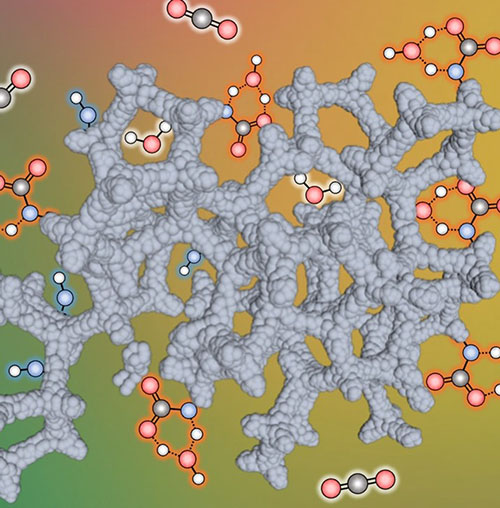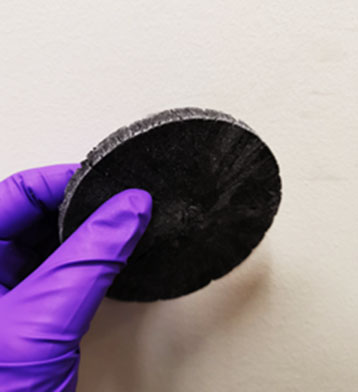| Aug 28, 2023 | |
Plant-based hydrogels use sunlight for sustainable carbon capture |
|
| (Nanowerk Spotlight) The escalating climate crisis has intensified the global search for sustainable solutions to counteract the adverse effects of greenhouse gas emissions. Carbon capture and storage (CCS), a method that involves selectively capturing and storing carbon dioxide (CO2) emissions, has emerged as a promising strategy. However, traditional methods have their limitations. | |
| Historically, the primary method for CCS involved using aqueous amine solutions to absorb CO2 from flue gases. However, this method is energy-intensive and has stability issues with the amine solutions used. As a result, researchers have been exploring alternative materials and methods like porous solid sorbents that could potentially increase carbon dioxide uptake capacity while reducing the energy needed to recycle them. | |
| Now, researchers at MIT have developed a new class of sustainable carbon capture hydrogel films (SCCHs) that can effectively capture carbon dioxide even from dilute sources like ambient air. | |
| The hydrogels are created from inexpensive, renewable biomass materials – a blend of hydrophilic konjac gum, thermos-responsive renewable cellulose, and polyethylenimine (PEI). Their hierarchical porous structure promotes rapid transport of carbon dioxide and provides easy access for the polyethylenimine amine sites to chemically bind the gas molecules. What sets these hydrogels apart, however, is their unique ability to function in humid conditions. | |
| Unlike traditional solid sorbents that often falter in humid conditions, SCCHs are designed to thrive. The presence of pre-captured water vapor in the hydrogel enhances the CO2 binding with PEI, leading to a much higher capture capacity under humid conditions. This unique ability to function optimally in a wide range of relative humidity sets SCCHs apart from their predecessors. | |
| The team published their findings in Nano Letters ("Scalable Biomass-Derived Hydrogels for Sustainable Carbon Dioxide Capture"). | |
 |
|
| Water molecule enhanced CO2 binding with nano-bump morphology of sustainable carbon capture hydrogel films. (Image: Youhong Guo) | |
| "Most solid sorbent-based systems that capture carbon dioxide from diluted sources struggle to function well in humid conditions and have high regeneration temperatures or require vacuum conditions," the paper’s first author, Youhong Guo, explains. “Our hydrogel films overcome these limitations through their hydrophilic components and temperature responsive cellulose polymer. The pre-absorbed moisture in the hydrogels significantly enhances carbon dioxide binding. The captured water forms hydronium ions that help stabilize zwitterions, which are reaction intermediates, allowing more efficient use of amine sites in the material.” | |
| This moisture boost results in exceptional uptake - around 4.5 mmol/g from 1-15% carbon dioxide at room temperature and pressure. Impressively, the hydrogels can capture 3.6 mmol/g from just 400 ppm, the concentration present in ambient air. | |
| Another notable advantage of SCCHs is their low regeneration temperature. Traditional methods often require high temperatures or vacuum conditions for regeneration, making them energy-intensive. However, thanks to the thermoresponsive nature of the hydroxypropyl cellulose, SCCHs can release over 80% of the captured CO2 at a temperature of around 60 °C within 50 minutes and without vacuum conditions. | |
| This temperature is achievable through solar power, highlighting the potential for a truly sustainable carbon capture method that harnesses natural energy sources. | |
| Multiple adsorption-desorption cycles showed no degradation, indicating excellent stability. According to Guo, the process of creating these hydrogels is both simple and scalable. She says, “they can be made using commercially available materials at a low cost, dissolved in water, poured into molds, and then subjected to a freeze-drying process.” | |
 |
|
| Photograph of a bulk sustainable carbon capture hydrogel film. (Image: Youhong Guo) | |
| The researchers anticipate that their biomass-derived hydrogels could reduce energy consumption compared to traditional temperature-swing sorbents and help advance sustainable carbon capture technologies. | |
| The versatility of the hydrogel platform also means optimizations are possible for even better performance. Work is ongoing to further lower costs, improve stability and durability, and adapt the materials for real-world conditions. | |
| Guo explains that a current focus is reducing the energy required saying, "Lowering energy consumption is the focus in terms of mitigating greenhouse gas emissions." While the hydrogel films already represent a significant advance, integration into carbon capture systems will require solving additional challenges around cost-effectiveness and avoiding generation of more pollution. | |
| Still, with continued research and development, sustainable carbon capture technologies like these hydrogels offer hope for managing global carbon dioxide emissions and making progress against climate change. | |
| In practical applications, the hydrogels can be placed in open air for pretreatment if the relative humidity is sufficiently high. Once pretreated, the hydrogels can capture CO2 from the atmosphere. After the capture process, the CO2 can be released either through electric heating or natural sunlight irradiation, making SCCHs a versatile solution suitable for various conditions and environments. | |
| While still requiring optimization, the hydrogel films demonstrate the promise of sustainable materials for carbon capture. With focused research to enhance real-world integration, similar nature-inspired technologies may soon provide viable solutions to counter global emissions and limit the climate crisis. | |
 By
Michael
Berger
– Michael is author of three books by the Royal Society of Chemistry:
Nano-Society: Pushing the Boundaries of Technology,
Nanotechnology: The Future is Tiny, and
Nanoengineering: The Skills and Tools Making Technology Invisible
Copyright ©
Nanowerk LLC
By
Michael
Berger
– Michael is author of three books by the Royal Society of Chemistry:
Nano-Society: Pushing the Boundaries of Technology,
Nanotechnology: The Future is Tiny, and
Nanoengineering: The Skills and Tools Making Technology Invisible
Copyright ©
Nanowerk LLC
|
|
|
Become a Spotlight guest author! Join our large and growing group of guest contributors. Have you just published a scientific paper or have other exciting developments to share with the nanotechnology community? Here is how to publish on nanowerk.com. |
|
